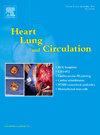A Comparison of Prescribing Guideline-Advocated Treatment for Heart Failure at Discharge from Cardiology and Non-Cardiology Wards
IF 2.2
4区 医学
Q2 CARDIAC & CARDIOVASCULAR SYSTEMS
引用次数: 0
Abstract
Background
Adherence to heart failure (HF) management guidelines is important to optimise clinical outcomes but can be variable in practice. This study compared prescribing guideline-advocated pharmacological and non-pharmacological management of HF between patients discharged from cardiology and non-cardiology wards.
Method
A retrospective audit of electronic medical records was undertaken of patients discharged from cardiology (n=100) or non-cardiology wards (n=100) of a tertiary hospital with a primary diagnosis of HF. Non-pharmacological management was quantified from documentation in medical records. Drug prescription was determined based on patients’ discharge summaries. Comparisons between wards were conducted using Student’s t-tests or Mann–Whitney U tests for continuous data and chi square tests or Fisher’s tests for categorical data. Binary logistic regression modelling was applied.
Results
Patients discharged from non-cardiology wards were older and had a higher incidence of hypertension, ischaemic heart disease, and renal insufficiency than those discharged from cardiology wards. The prescription of angiotensin-converting enzyme inhibitors (ACEIs)/angiotensin II receptor blockers (ARBs)/angiotensin receptor neprilysin inhibitors (ARNIs) and mineralocorticoid receptor antagonists at any dose (52% vs 80%; p<0.01, 25% vs 52%; p<0.01, respectively) were lower in non-cardiology than in cardiology wards, but there was no difference between wards for beta blockers. Referral to cardiac rehabilitation (4% vs 28%; p<0.01) before discharge was significantly lower in non-cardiology wards. Increased age was associated with less likelihood of the prescription of ACEIs/ARBs/ARNIs and mineralocorticoid receptor antagonists at any dose and ≥50% target dose. Better renal function was a predictor for ACEIs/ARBs/ARNIs at any dose and ≥50% target dose. Discharge ward was not in itself an independent predictor of drug prescription at any dose or for any drug class.
Conclusions
Prescription rates with key components of pharmacological and non-pharmacological HF management were lower in non-cardiology than in cardiology wards. For pharmacological management, this appeared related to higher patient complexity rather than the ward. Quality improvement programs to strengthen adherence to guideline-advocated treatment is warranted to optimise care, especially for higher complexity admitted to a non-cardiology ward.
求助全文
约1分钟内获得全文
求助全文
来源期刊

Heart, Lung and Circulation
CARDIAC & CARDIOVASCULAR SYSTEMS-
CiteScore
4.50
自引率
3.80%
发文量
912
审稿时长
11.9 weeks
期刊介绍:
Heart, Lung and Circulation publishes articles integrating clinical and research activities in the fields of basic cardiovascular science, clinical cardiology and cardiac surgery, with a focus on emerging issues in cardiovascular disease. The journal promotes multidisciplinary dialogue between cardiologists, cardiothoracic surgeons, cardio-pulmonary physicians and cardiovascular scientists.
 求助内容:
求助内容: 应助结果提醒方式:
应助结果提醒方式:


